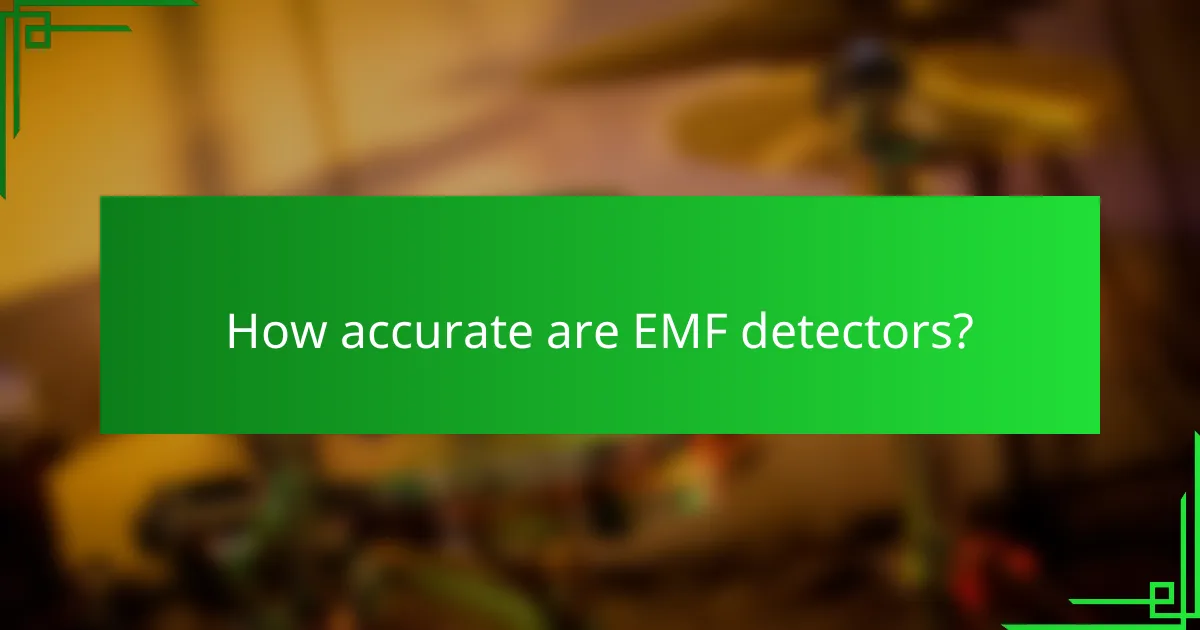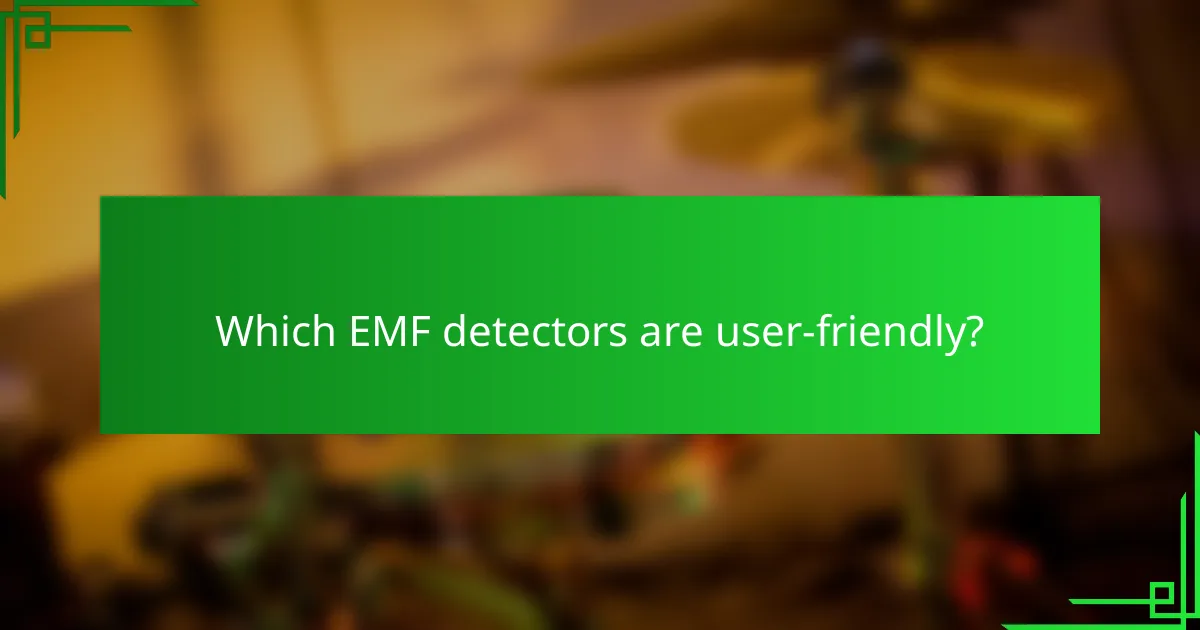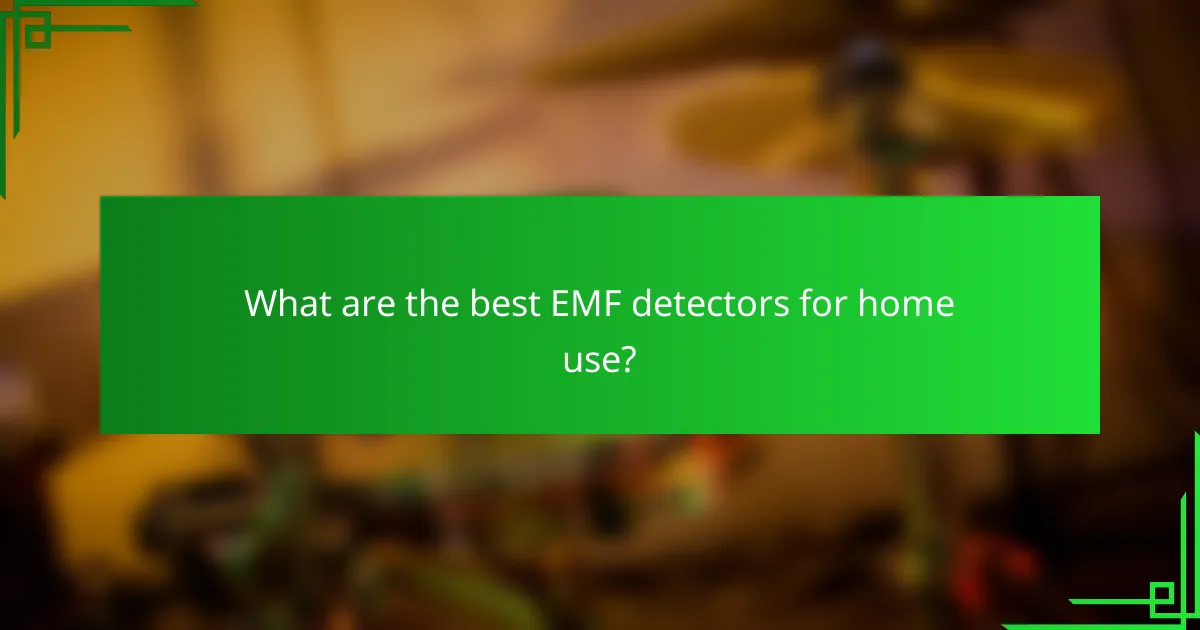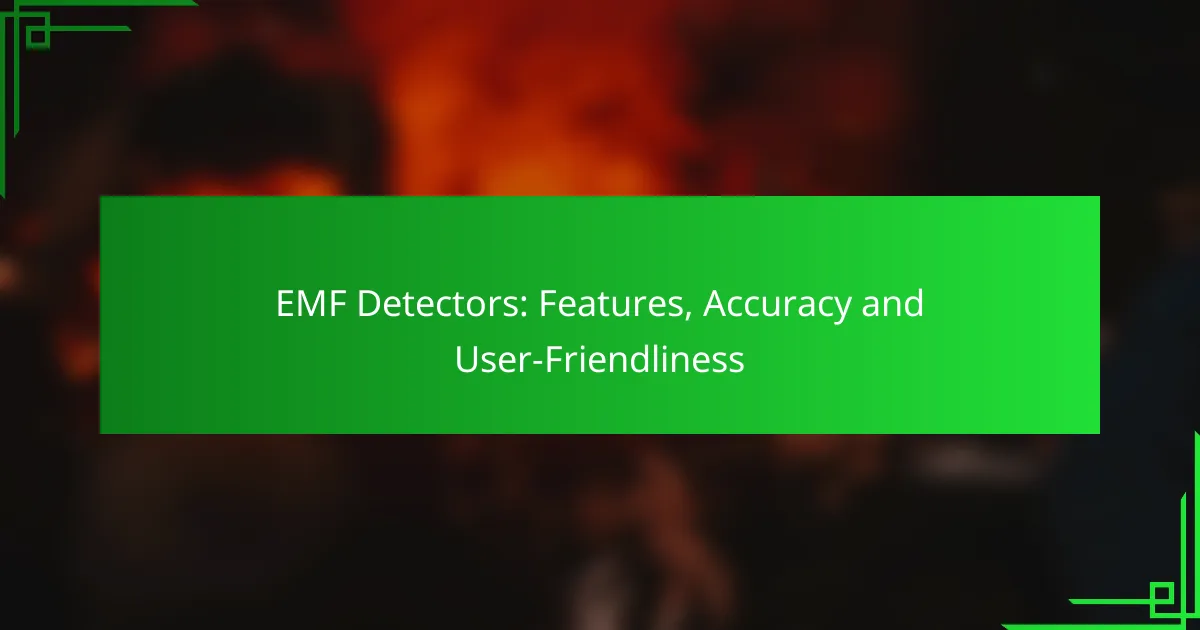EMF detectors are essential tools for measuring electromagnetic fields emitted by various sources, including electronic devices and power lines. When selecting an EMF detector, it’s important to consider features such as frequency range, display type, and portability, which enhance usability and effectiveness. Accuracy can vary widely among models, with consumer-grade options offering general readings and professional-grade devices providing precise measurements for more detailed analysis.

How do EMF detectors work?
EMF detectors function by measuring electromagnetic fields emitted by electronic devices, power lines, and other sources. They typically use sensors to detect changes in electromagnetic radiation and convert these measurements into readable data for users.
Detection of electromagnetic fields
EMF detectors identify electromagnetic fields by sensing the intensity and frequency of radiation in the environment. These devices can detect both low-frequency fields, such as those from household appliances, and higher-frequency fields from wireless technologies. The effectiveness of detection can vary based on the type of sensor used and the surrounding materials.
Common sensors include analog meters, which provide a continuous reading, and digital meters, which display measurements numerically. Users should consider the sensitivity and range of the detector when assessing its capability to identify different electromagnetic sources.
Types of EMF detectors
There are several types of EMF detectors, each designed for specific applications. Basic models, like single-axis meters, measure fields in one direction, while more advanced models, such as tri-axis meters, can measure fields from multiple directions simultaneously.
Some detectors are specifically designed for low-frequency electromagnetic fields, while others can measure radiofrequency radiation. When selecting an EMF detector, consider the intended use, whether for home safety, professional assessments, or scientific research.
Measurement units used
EMF detectors typically measure electromagnetic fields in units such as milligauss (mG) for low-frequency fields and volts per meter (V/m) for radiofrequency fields. Understanding these units is crucial for interpreting the readings accurately.
For example, low-frequency fields from household appliances usually range from 0.5 to 100 mG, while radiofrequency fields can vary widely depending on the source, often measured in microvolts per meter (µV/m). Familiarity with these units helps users assess exposure levels relative to safety guidelines and regulations.

What features should I look for in an EMF detector?
When choosing an EMF detector, consider features that enhance its effectiveness and usability. Key aspects include frequency range, display type, data logging capabilities, and portability, which all contribute to the detector’s performance in measuring electromagnetic fields.
Frequency range
The frequency range of an EMF detector indicates the spectrum of electromagnetic fields it can measure. Look for detectors that cover a wide range, typically from 1 Hz to several GHz, to ensure they can detect both low-frequency and high-frequency emissions.
For practical use, a detector with a range of 10 MHz to 3 GHz is suitable for most household applications, including wireless devices and appliances. Ensure the device can accurately measure the frequencies relevant to your environment.
Display type
The display type of an EMF detector affects how easily you can read and interpret measurements. Digital displays are common and often provide numerical readings, while analog displays may offer a visual representation of field strength.
Consider a model with a backlit display for use in low-light conditions. Some detectors also feature graphical displays that show real-time changes in EMF levels, which can be particularly useful for identifying sources of radiation.
Data logging capabilities
Data logging capabilities allow an EMF detector to record measurements over time, which is valuable for tracking exposure levels. Look for devices that can store data for later analysis, either internally or via external connections.
Some detectors offer software compatibility for detailed analysis, enabling users to visualize trends and patterns in EMF exposure. This feature is especially beneficial for professionals conducting thorough assessments in various environments.
Portability
Portability is crucial for an EMF detector, especially if you plan to use it in multiple locations. Lightweight and compact designs are easier to carry and handle, making them more user-friendly for on-the-go measurements.
Choose a model with a durable build and a protective case to ensure it withstands frequent transport. Battery-operated devices enhance portability, allowing for measurements in areas without immediate access to power sources.

How accurate are EMF detectors?
EMF detectors can vary significantly in accuracy based on their design, calibration, and intended use. Most consumer-grade models provide a general indication of electromagnetic field strength, but professional-grade detectors can offer precise measurements within specific ranges.
Calibration standards
Calibration standards for EMF detectors ensure that measurements are consistent and reliable. Many devices adhere to international standards such as IEC 61000-4-3, which outlines testing methods for electromagnetic fields. Regular calibration is essential for maintaining accuracy, especially in professional settings.
Users should check if their EMF detector requires periodic recalibration and follow the manufacturer’s guidelines. This practice helps ensure that the readings remain valid over time.
Comparison of popular models
When comparing popular EMF detectors, consider factors like frequency range, sensitivity, and display features. Models such as the Trifield TF2 and the Cornet ED88T offer different strengths; for instance, the Trifield TF2 is known for its ease of use, while the Cornet ED88T provides broader frequency coverage.
Price points can vary widely, with consumer models typically ranging from $30 to $200, while professional-grade detectors may cost several hundred dollars. Assessing user reviews can also provide insights into real-world accuracy and reliability.
Common accuracy issues
Common accuracy issues with EMF detectors often stem from environmental factors, such as nearby electronic devices or metal objects that can interfere with readings. Additionally, some low-cost models may not accurately measure high-frequency fields, leading to misleading results.
To mitigate these issues, users should conduct measurements away from potential interference sources and ensure the device is properly calibrated. Regularly updating knowledge on the device’s specifications can also help in understanding its limitations.

Which EMF detectors are user-friendly?
User-friendly EMF detectors are those that are easy to operate, understand, and interpret. They typically feature intuitive interfaces, clear displays, and straightforward measurement processes, making them suitable for both beginners and experienced users.
Top-rated user-friendly models
Some of the top-rated user-friendly EMF detectors include the Trifield TF2, the EMF-390, and the Cornet ED88T. These models are known for their simple operation and effective performance, often featuring one-button functionality and clear digital readouts. They are widely available online and in electronics stores, typically ranging from $50 to $200.
Ease of use features
User-friendly EMF detectors often come with features such as backlit displays, audio alerts, and automatic range adjustments. A backlit display allows for easy reading in low-light conditions, while audio alerts can signal when EMF levels exceed a certain threshold. Additionally, some models offer smartphone connectivity for enhanced data tracking and analysis.
User reviews and feedback
User reviews frequently highlight the importance of simplicity and accuracy in EMF detectors. Many users appreciate models that provide instant readings without complicated settings. Feedback often emphasizes the value of clear instructions and customer support, which can significantly enhance the user experience, especially for those new to EMF detection.

What are the best EMF detectors for home use?
The best EMF detectors for home use combine accuracy, user-friendliness, and essential features to measure electromagnetic fields effectively. Look for models that can detect both low and high-frequency radiation, ensuring comprehensive monitoring of your living environment.
Best models for residential environments
Top models for residential use include the Trifield TF2, which measures electric, magnetic, and radio frequency fields, and the Cornet ED88T, known for its sensitivity and versatility. The Acoustimeter AM-10 is another popular choice, particularly for its ease of use and clear display.
When selecting a model, consider features like frequency range, display type, and battery life. User reviews can also provide insights into real-world performance and reliability.
Price range for home EMF detectors
The price range for home EMF detectors typically varies from around $30 to $300, depending on the features and accuracy levels. Basic models may suffice for casual users, while more advanced detectors are suitable for those needing precise measurements.
Investing in a mid-range detector often balances cost and functionality, providing reliable readings without breaking the bank. Look for sales or discounts to maximize value.
Shipping and return policies
Shipping policies for EMF detectors generally depend on the retailer, with many offering free shipping on orders over a certain amount. Check for estimated delivery times, especially if you need the device quickly.
Return policies can vary widely; some retailers provide a 30-day return window, while others may offer longer periods. Always review the return policy before purchasing to ensure you can return or exchange the product if it doesn’t meet your needs.

How do I choose the right EMF detector?
Choosing the right EMF detector involves considering its sensitivity, frequency range, and user-friendliness. Look for models that meet your specific needs, whether for professional use or personal safety, and ensure they comply with local regulations.
Decision criteria
When selecting an EMF detector, prioritize features such as measurement range, accuracy, and ease of use. A good detector should cover a wide frequency range, typically from 0 Hz to several GHz, to capture various electromagnetic fields.
Consider the type of EMF you need to measure: electric fields, magnetic fields, or radiofrequency radiation. Some detectors specialize in one area, while others provide a comprehensive analysis. User reviews can provide insight into reliability and performance.
Comparison chart of features
| Feature | Basic Model | Intermediate Model | Advanced Model |
|---|---|---|---|
| Frequency Range | 50 Hz – 2 kHz | 50 Hz – 10 MHz | 0 Hz – 10 GHz |
| Accuracy | ±10% | ±5% | ±1% |
| User-Friendly Interface | Basic LCD | Backlit LCD | Touchscreen |
| Data Logging | No | Yes | Yes, with software |
Compare these features to determine which model suits your needs best. Basic models are often sufficient for casual users, while professionals may require advanced models with higher accuracy and data logging capabilities.
